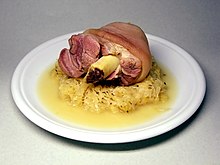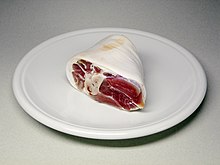Knuckle of pork

The knuckle of pork - also known as Hachse , Haxe , Haxn or Schweinshaxe , Knöchla , Hechse , Hämchen , Bötel , also called Haspel in Hessian , in Austria stilt , in Bavarian Schweinshaxn , Franconian also known as Knöchla or Adlerhaxe , Swiss Gnagi or Wädli - is a Meat dish . It is the part of the pig's leg that is between the knee or elbow joint and the tarsal joints and, in humans, corresponds to the forearm or lower leg.
Knuckle of pork is very streaky and surrounded by a thick layer of fat . The meat is very tender and aromatic, but has to be cooked for a long time. It should be easy to remove from the bone with all cooking methods , boiled or grilled .
Colloquially , cold feet are also referred to as ice legs.
preparation
The method of preparation varies by region, but there are two main variants: While in northern Germany and Poland most vorgepökelt and then cooked , it becomes in southern Germany , the Czech Republic and Austria in general ungepökelt oven- roasted or grilled , whereby the rind tenderizing in a Crust transformed. The result of this preparation is called knuckle, while pork knuckle always refers to the cooked one.
Mostly it is used for hearty, simple dishes, in Berlin for example cooked with pea puree , in Franconia as "Kraut und Knöchla" with sauerkraut and mashed potatoes or bread . For the Austrian preparation ("stilt") it is often pre-cooked in a garlic and caraway stock, after which it is placed in the oven or on the grill until the skin is crispy. Stilt is traditional with mustard , horseradish (horseradish) and vinegar served pickled vegetables.
The enjoyment of pork knuckle is often carried out as a sociable event by clubs with sometimes over 5000 participants. In Austria it is also organized in connection with the Schnapsen card game as a so-called stilt schnapps , where you can win a stilt at a time.
etymology
Knuckle of pork
There are different explanations for the origin of the term pork knuckle . According to the more widespread, which probably comes from folk etymology , it is derived from the earlier common use of the shins as a material for skate blades, called islegg in Norwegian , to legg "leg, bone tube ". Alternative explanation is that knuckle to the Old High German īsbēn back, an old word from the jargon of hunters and physicians for the hip bone , probably borrowed from Latin Ischia "hip", in turn from Greek ischíon "hip bone" that by shifting meaning only in NHG the Called the lower leg.
Shank
The terms Hachse , Hechse , Haxe go back to the Old High German hāhs (i) na "Achilles tendon, knee bend of the hind leg", the origin of which is unclear. It may be related to the Latin coxa "hip", which would mean a shift in meaning comparable to the knuckle of pork .
Web links
Individual evidence
- ↑ Grilled pork knuckle I'm thick! on Spiegel Online , accessed February 18, 2018
- ^ "Der Sprach-Brockhaus", Verlag Eberhard Brockhaus, Wiesbaden 1949, page 142.
- ^ F. Naumann: Eisbeinessen (the association of Hamburg ship brokers). In: Hansa 2008 No. 12 pp. 52–56
- ↑ Theo Stemmler: Duden - How the pork knuckle got into the lexicon: An entertaining walk through the German word history . Dudenverlag, Bibliographisches Institut, Mannheim, 2007, ISBN 978-3-411-72291-4
- ^ Friedrich Kluge: Etymological Dictionary , de Gruyter, Berlin / New York 1995, ISBN 3-11-012922-1
- ^ Friedrich Thiele: German and English usage in mutual illumination . German Quarterly, 1938
- ↑ Duden Etymology . Bibliographical Institute Mannheim, 1963
- ^ Friedrich Kluge, Elmar Seebold: Etymological Dictionary of the German Language , Verlag De Gruyter, 24th edition 2002. ISBN 978-3-11-017473-1




